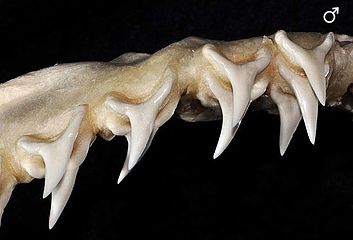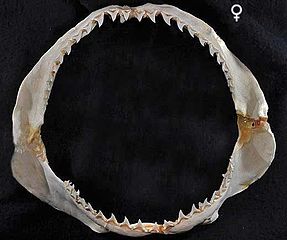Bigeye thresher
| Bigeye thresher Temporal range:
| |
|---|---|

| |
| Scientific classification | |
| Domain: | Eukaryota |
| Kingdom: | Animalia |
| Phylum: | Chordata |
| Class: | Chondrichthyes |
| Subclass: | Elasmobranchii |
| Subdivision: | Selachimorpha |
| Order: | Lamniformes |
| Family: | Alopiidae |
| Genus: | Alopias |
| Species: | A. superciliosus
|
| Binomial name | |
| Alopias superciliosus (R. T. Lowe, 1840)
| |

| |
| Range of the bigeye thresher | |
| Synonyms | |
|
Alopecias superciliosus R. T. Lowe, 1840 | |
The bigeye thresher (Alopias superciliosus) is a species of
The large eyes of the bigeye thresher are
Taxonomy and phylogeny
British biologist
An
Distribution and habitat
The bigeye thresher has a virtually circumtropical distribution. In the western
Bigeye threshers are usually found over the continental shelf and in the open sea, though they are occasionally encountered in shallow coastal waters. They occur in surface temperatures of 16–25 °C (61–77 °F), but have been tracked as far down as 723 m (2,372 ft), where the temperature is only 5 °C (41 °F).[6][10] Little is known of their geographical movements; one individual has been documented moving from New York to the Gulf of Mexico, a straight-line distance of 2,767 km (1,719 mi).[11]
Description
The eyes of the bigeye thresher can measure up to 10 cm (3.9 in) across in adults. Each eye is taller than wide, with a bulbous upper portion. The orbits extend onto the
Up to half the body length is taken up by the long upper lobe of the caudal fin, which is broader than in other threshers. The large
Biology and ecology
The size and upward orientation of the bigeye thresher's eyes are adapted to search for the silhouettes of prey in dim light.[6] This species is one of a handful of shark species that conducts a diel vertical migration, spending daytime in deeper water between 300–500 m (980–1,640 ft), beneath the thermocline where the temperature ranges from 6 to 12 °C (43 to 54 °F), and ascending above it to water less than 100 m (330 ft) deep during nighttime.[11] This migration likely relates to finding prey at night and avoiding predators during the day. The sharks' daytime swimming patterns are usually steady, while at night they have a pattern of slow ascents and rapid descents.[10]
Bigeye threshers are likely preyed upon by larger sharks and
-
Dorsal view of a bigeye thresher, showing upward-facing eyes and prominent lateral grooves.
-
Teeth, male
-
Teeth, male
-
Teeth, female
-
Teeth, female
Feeding

The bigeye thresher has larger teeth than other threshers and feeds on a wider variety of prey. Known food items include
Life history
Like other
Thermoregulation
There is conflicting evidence on whether the bigeye thresher is
Human interactions

The bigeye thresher shark is rarely encountered by divers underwater and poses no danger. This species is or was taken by longline
In the waters of the
References
- ^ .
- ^ . Retrieved 19 November 2021.
- ^ "Appendices". Convention on International Trade in Endangered Species of Wild Fauna and Flora. Retrieved 2022-01-14.
- ^ Lowe, R. T. (1839). "Description of some new species of Madeiran fishes, with additional information relating to those already described". Proceedings of the Zoological Society of London. 8: 36–39 – via Biodiversity Heritage Library.
- ^ ISBN 92-5-104543-7.
- ^ ISBN 0-520-23484-7.
- ^ a b c d e f g Jensen, C. Bigeye Thresher. Florida Museum of Natural History. Retrieved December 21, 2008.
- JSTOR 1446753.
- ^ Trejo, T. (2005). "Global phylogeography of thresher sharks (Alopias spp.) inferred from mitochondrial DNA control region sequences". MSc thesis. Moss Landing Marine Laboratories, California State University.
- ^ .
- ^ a b c Weng, K.C. & Block, B.A. (2004). "Diel vertical migration of the bigeye thresher shark (Alopias superciliosus), a species possessing orbital retia mirabilia". Fishery Bulletin – National Oceanic and Atmospheric Administration. 102 (1): 221–229.
- ^ a b c d e f Martin, R.A. Biology of the Bigeye Thresher (Alopias superciliosus). ReefQuest Centre for Shark Research. Retrieved on December 21, 2008.
- OCLC 38468784. Retrieved 13 July 2021.
- ^ Cressey, R. (1964). "A new genus of copepods (Caligoida, Pandaridae) from a thresher shark in Madagascar". Cahiers O.R.S.T.O.M. Océanographie. 2 (6): 285–297.
- S2CID 4828139.
- ^ S2CID 13641670.
- JSTOR 1444380.
- .
- PMID 16272248.
- OCLC 1042901090.
External links






